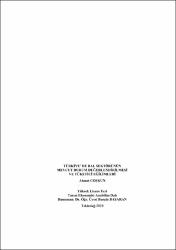| dc.contributor.author | Coşkun, Ahmet | |
| dc.date.accessioned | 2020-02-14T08:32:07Z | |
| dc.date.available | 2020-02-14T08:32:07Z | |
| dc.date.issued | 2019 | |
| dc.identifier.uri | https://hdl.handle.net/20.500.11776/3604 | |
| dc.description.abstract | Ülkemizde 2018 yılında üretilen 108 bin ton balın yaklaşık yarısı ambalajlı bal olarak satılmakta, diğer yarısı ise kontrolsüz bir şekilde açıkta ya da direk arıcılar tarafından satılmaktadır. Son yıllarda bal ile ilgili artan taklit ve tağşiş haberleri tüketicileri ambalajlı bal alma konusunda tedirgin edebilmektedir. Bu çalışmanın amacı bal sektörü ve ambalajlı bal üreten firmalar hakkında bilgi sağlamanın yanında tüketicilerin bal satın alırken nelere dikkat ettiklerini belirlemektir. Elde edilen bulgulardan hareketle gerek arıcıların gerekse sektördeki firmaların pazarlama stratejilerine katkı sağlamak ve tüketicilere bal hakkında doğru bilgiler vermektir. Bu araştırma, Türkiye’de bal sektörünün genel durumunu ortaya koymak ve İstanbul örneği ele alınarak bal tüketim eğilimlerini araştırmak amacıyla yapılmıştır. Bunun için İstanbul ili kentsel alanında yaşayan 288 tüketici ile yüz yüze anket çalışması yapılarak orijinal veriler elde edilmiştir. İstanbul ilindeki tüketicilerin bal tüketim davranışları, ailelerin sosyo-ekonomik özellikleri ve öğrenim durumları bakımından da incelenmiştir. Araştırma alanındaki tüketicilerin %67,9’u çiçek balını tercih etmekte, %69’u süzme bal tüketmektedir. Kaynağına göre etiketlenerek satılan monoflora ballarına, yöresel etiketli ballara ve organik etiketli ballara fazla ilgi gösterilmemektedir. Tüketiciler en çok 501-1000 gr’lık ambalajları tercih etmekte ve genelde balı marketten almakta, en çok sonbahar mevsiminde bal alımı yapılmaktadır. Tüketiciler balı %94,8 oranında kahvaltıda tüketmektedirler. En çok Doğu Anadolu yöresi balları tercih edilmekte, %41,7 oranında hem markalı hem de markasız bal tüketilmektedir. Kristalize olan bal hakkında ise doğal yapısı gereğidir diyenlerin oranı %85,4’tür. Elde edilen sonuçlara göre bal ambalajlarındaki menşei, yöresi ve organik ifadelerinin hangi şartlarda yer alabildiğinin tüketicilerce yeterince bilinmediği görülmüştür. Markalı bala bariz bir yönelimin olmaması da tüketicilerde ambalajlı bala olan güvensizliğin göstergesi olabilir. Bu konuda bakanlıkça tüketicilere gerekli bilgilendirmelerin yapılması, bal satan kişi ve yerlere yapılan denetimlerde de nitelik ve bilgilendirmeye önem verilmesi bala olan güveni arttırabilecektir | en_US |
| dc.description.abstract | Approximately half of the 108 thousand tons of honey produced in our country in 2018 is sold as packaged honey and the other half is sold uncontrolled in the open or directly by beekeepers. Increasing imitation and adulteration news about honey in recent years can make consumers uneasy about buying packaged honey. The aim of this study is to provide information about honey sector and packaged honey producing companies as well as to determine what consumers pay attention to when buying honey. Based on the findings, it is aimed to contribute to the marketing strategies of both beekeepers and companies in the sector and to provide accurate information about honey to consumers. This research reveals the general situation by taking samples of the honey sector in Turkey and Istanbul was conducted to investigate the honey consumption trends. For this purpose, original data were obtained by conducting a face-to-face survey with 288 consumers living in urban areas of Istanbul. Honey consumption behaviors of consumers in Istanbul were examined in terms of socio-economic characteristics and educational status of families. 67.9% of the consumers in the research area prefer flower honey and 69% consume strained honey. Monoflora honey, locally labeled honey and organic labeled honey are not paid much attention. Consumers prefer the most 501-1000 gr packages and usually buy honey from the market. Honey is mostly bought in the autumn season. Consumers consume honey for breakfast at a rate of 94.8%. Eastern Anatolia region honey is preferred, both branded and unbranded honey is consumed at a rate of 41.7%. The ratio of those who say about crystallized honey is by nature is 85.4%. According to the results obtained, it was seen that the conditions of origin, region and organic expressions in honey packages could not be known enough by the consumers. The lack of an obvious orientation to branded honey may also be indicative of the mistrust of packaged honey in consumers. Providing the necessary information to the consumers by the ministry and giving importance to quality and information in the audits conducted to the people and places that sell honey may increase the confidence in honey. | en_US |
| dc.language.iso | tur | en_US |
| dc.publisher | Namık Kemal Üniversitesi | en_US |
| dc.rights | info:eu-repo/semantics/openAccess | en_US |
| dc.subject | Bal | en_US |
| dc.subject | tüketici davranışı | en_US |
| dc.subject | marka | en_US |
| dc.subject | bal pazarlama | en_US |
| dc.subject | Honey | en_US |
| dc.subject | consumer behavior | en_US |
| dc.subject | trademark | en_US |
| dc.subject | honey marketing | en_US |
| dc.title | Türkiye’de bal sektörünün mevcut durum değerlendirilmesi ve tüketici eğilimleri | en_US |
| dc.title.alternative | ASSESSMENT OF CURRENT SITUATION IN TURKEY’S HONEY INDUSTRY AND CONSUMER TRENDS | en_US |
| dc.type | masterThesis | en_US |
| dc.department | Enstitüler, Fen Bilimleri Enstitüsü, Tarım Ekonomisi Ana Bilim Dalı | en_US |
| dc.relation.publicationcategory | Tez | en_US |



















